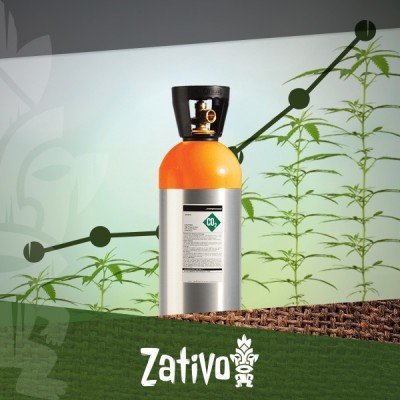Don't have an account?
Register NowYou have to add to cart at least 5 bottles or any program to make checkout.
- BlogAdd CO2 To Your Grow Room And Boost Yields
Add CO2 To Your Grow Room And Boost Yields
Published: February 28th, 2017
Categories:
Cannabis Cultivation
When growing indoors, growers need to go to great lengths to simulate a natural environment in which their weed plants can thrive in order to produce the optimum quantity yield and the most amount of it.
Some of the fundamentals involved in creating such an environment include nutrients, water, lighting, and air. Nutrients and water are obvious factors involved in maintaining the health of marijuana plants. And powerful lights are a must to optimize plant growth and the size of a harvest.
Yet air quality is perhaps the most underappreciated and unnoticed when it comes to raising a crop of cannabis. CO2, required for photosynthesis, is often overlooked. If done correctly, CO2 can be an enormous boost for your cannabis plants.
We all learned about the process of photosynthesis in biology class. This is a process of energy production that plants can achieve when they have the correct resources in their external environment.
Your marijuana plants need adequate levels of carbon dioxide and water in the environment to enable them to convert sunlight (or light emitted from artificial grow lights if raising them indoors) into the green pigment known as chlorophyll that gives many plants their luscious green appearance.
It is also the substance that plants use to absorb different wavelengths of light from a light source. Chlorophyll is then utilized by plants to create glucose and oxygen.
So it’s quite clear that the presence of carbon dioxide is paramount to the health and vitality of cannabis plants. It would then make sense to include this factor when growing, just as importantly as the correct balance of nutrients, the right amount of water at the right time and an adequate amount of light.
CO2 FOR YOUR CANNABIS?
Boosting levels of CO2 within the growing environment can significantly increase the size of your yields, but it is not as simple as pumping gas into your grow space without working a few things out first.
For example, if you are supplying your plants with low powered light sources such as CFLs and fluorescent lights then they likely have enough CO2 in their surroundings to make full use of the light they are being given due to the standard levels of CO2 in the air.
However, growers using higher powered lights, such as LEDs, or those wishing to step up the game and use them are providing their plants with such a good source of light that it is worth introducing CO2 into the grow room.
This is because, in this situation, the plants will be able to properly utilize the extra light when increased levels of CO2 are provided. On top of this, it will also make your plants more resilient to the heat being given off by bigger lights.
THE BENEFITS OF USING CO2
CO2 can boost your plant's size, growing speed and flower output when the other ingredients such as strong lights are present. CO2 may also add an element of stealth to your indoor growing. This is because it is not ideal to ventilate your grow space whilst using CO2 within it to ensure you are not losing the supplemented air, although in some conditions it is necessary. This means air carrying the scent of your dank green crop will remain within the grow space, it won’t be blown outside where it may arouse unwanted suspicions
There are several ways a grower can go about adding CO2 to their grow space.
CO2 TANKS
Using a CO2 tank to pump the grow space with CO2 is a popular method. Tanks can be equipped with a controller which can then be paired with a fan if you are choosing to use ventilation. This controller can then be used to pump air in for your plants when levels are down, and then flush out the grow space when temperatures are starting to peak.
CO2 BURNERS
CO2 burners work by burning fuel such as butane or propane to put CO2 into the grow environment. Although effective, this method comes with obvious risks. To maintain safety, place a carbon monoxide detector within the grow space to avoid leakage.
CO2 BAGS
These gnarly little bags are simple and easy to use, although for them to produce an effective result growers might have to employ rather a lot of them. CO2 bags use a type of fungi that grows on a source of organic matter which then emits CO2.
DRY ICE
This method uses solid CO2 which is released into the air when it is warmed up. A bonus of using this method is that this substance will actually bring the temperature in the grow room down slightly when used.
MAKE IT RAIN
When using CO2 as an air supplement you should place your source in a position so that the gasses fall down onto your plants from above, this is because CO2 is heavier than air and will start to sink. A fan can be used to keep the gas circulating.
VEGETATIVE STAGE
CO2 is very effective during this period of a plant's life cycle and can be kept pumping during daylight. However, it should be turned off during the night hours as this is when plants stop photosynthesizing and start respiring, needing oxygen instead of carbon dioxide to do so.
FLOWERING STAGE
It is debatable if CO2 makes a huge difference during different times of the flowering stage. It is recommended to use it during the first 3 weeks, yet optional to use it all the way through the process and judge the effectiveness for yourself if you are willing to experiment.





